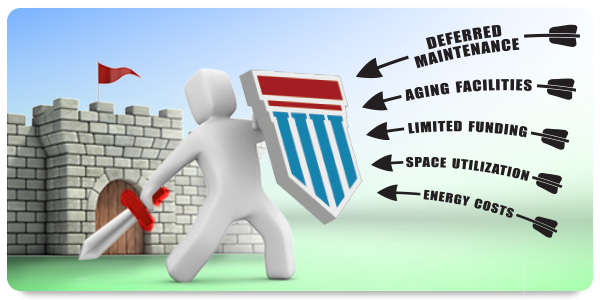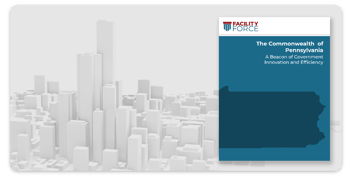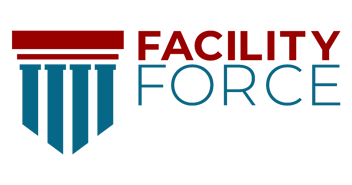When you search for the term, “IWMS” (Integrated Workplace Management System), you'll find lots of results for IWMS software vendors. These solutions often seem better suited to real estate and commercial organizations, directed at facilities professionals managing millions of square feet of office, warehouse, and manufacturing space for private sector companies.
To find more meaningful results, we recommend using the search term “best IWMS software for Government.” By adding "for Government" to IWMS, you'll discover results that are more relevant and useful for those responsible for maximizing the useful life of public sector facilities and assets—such as Directors of Facilities, Directors of Real Estate, Directors of Public Works, and similar department heads across various agencies.
Table of Contents:
- Why IWMS Software for Government?
- Facilities-Related Problems Facing Government
- Benefits of IWMS Software
- Results from Implementing an IWMS
- Key Capabilities of IWMS Software
- Conclusion
Why IWMS Software for Government?
The reason "why" is fairly straightforward. Companies and Government organizations have different perspectives on their property portfolios, and therefore different challenges and priorities. Private sector companies make decisions to maximize profits in the short-term, while public sector agencies must be good stewards of Government property and act in the public’s best interest over the long-term.
This doesn’t mean that an “integrated workplace management system” isn’t suitable for Government organizations, it just means you need to find an IWMS software solution designed specifically for Government needs.
Facilities-Related Problems Facing Government:
Finding the “best IWMS software for Government” is crucial due to the unique challenges Governments face, including aging facilities, deferred maintenance, increasing energy costs, limited funding for capital improvements, pressure to better utilize space, and more. Many of these problems were apparent even before March 11, 2020, when the World Health Organization (WHO) declared COVID-19 a global pandemic; however, the pandemic amplified some issues, such as space management.
Government Facilities Challenges:
-
Deferred Maintenance: Limited budgets often postpone necessary maintenance and capital improvements. Year after year, this backlog of deferred maintenance becomes harder to address. The National Association of State Facilities Administrators estimates that every dollar not spent on building maintenance could cost a state as much as $15 to $30 to fix the resulting problem.
-
Aging Facilities: Neglected buildings compound issues for Government agencies. These buildings impact the ability to serve the public, lead to higher maintenance and operation costs, and strain already limited resources, preventing preventive maintenance and capital projects on newer assets.
-
Limited Funding: Budget constraints make it challenging to maintain facilities properly, leading to a cycle of deferred maintenance and increasing long-term costs.
-
Space Utilization: Efficiently using space, planning for growth, and managing moves have always been challenging, exacerbated by the COVID-19 pandemic. Issues include equipping staff to work from home, determining new occupancy standards, and deciding on space redesigns or reconfigurations.
-
Energy Costs: Increasing energy costs add another layer of complexity, requiring Government agencies to find ways to reduce energy consumption and manage costs effectively.
Given these challenges, Government organizations must find ways to do more with less, which is where IWMS software can make a significant difference.
Benefits of IWMS Software for Government Agencies
Several benefits of IWMS software can help Government agencies address their unique challenges:-
- Visibility: IWMS software provides comprehensive visibility into real property assets, including space, energy, and operating programs, and their impact on capital.
- Accountability: By offering mechanisms for internal measurement and verification, IWMS software fosters accountability and provides documented evidence of savings.
- Transparency: Baseline reporting is readily available to all stakeholders, preventing data manipulation and promoting transparency.
- Monetization: IWMS software helps generate energy, space, and operational savings, reduce deferred maintenance backlogs, and increase asset lifecycles.
Expected Results from Implementing IWMS Software
By implementing IWMS software, Government organizations can become better stewards of their real estate, facilities, and assets. Specific benefits include:
- Operational and Maintenance Savings: Efficient management of maintenance and operations can lead to significant cost savings.
- Reduction in Equipment Downtime: Improved maintenance schedules and asset tracking reduce downtime.
- Indirect Cost Recovery: Better asset management helps recover indirect costs more effectively.
- Reduced Total Cost of Ownership (TCO): Optimizing asset use and maintenance lowers the total cost of ownership.
- Annualized Savings per Square Foot: Efficient space and energy management contribute to annualized savings.
- Reduced Energy Spend: Identifying and addressing energy inefficiencies lead to lower energy costs.
Key Capabilities of IWMS Software for Government:
To meet the complex needs of Government organizations, the best IWMS software should offer comprehensive capabilities across five key pillars: Real Estate and Property Management, Space Management, Operations and Maintenance (O&M), Capital Improvement, and Energy Management. Each pillar plays a crucial role in enhancing efficiency, accountability, and sustainability within Government facilities.
Real Estate and Property Management
Real Estate and Property Management is fundamental for Directors of Real Estate or Facilities to oversee every aspect of their portfolio. This capability includes:
Real Estate Database Management: A centralized database that stores detailed information about all real estate assets, including property locations, sizes, values, and utilization. This ensures accurate record-keeping and easy access to property data.
Lease Management: Tools to manage lease agreements, including tracking lease terms, renewal dates, and rental payments. This helps avoid missed deadlines and ensures compliance with lease agreements.
Property Management: Comprehensive features to oversee property operations, maintenance schedules, tenant relationships, and occupancy rates. This ensures properties are well-maintained and efficiently utilized.
Accounting and Budgeting: Integration with financial systems to manage budgets, track expenses, and forecast costs. This supports financial planning and ensures that spending aligns with budgetary constraints and priorities.
Transaction Management: Facilitates the buying, selling, and leasing of properties by providing detailed transaction histories and financial analyses to support decision-making.
Space Management
Space Management capabilities are essential for optimizing the use of space within Government facilities. This pillar provides:
Space Utilization Tracking: Detailed tracking of how space is used across all facilities, identifying underutilized areas and opportunities for optimization.
Space Planning and Allocation: Tools to plan and allocate space efficiently, supporting moves, additions, and changes. This includes visual floor plans and automated space assignments.
Occupancy Management: Real-time data on occupancy levels to ensure that space is used effectively and meets the needs of occupants. This includes managing desk reservations and shared spaces.
Cost Analysis: Pinpointing the total cost of owned and leased space, including maintenance, utilities, and other operational expenses. This helps identify cost-saving opportunities.
Space Standards and Compliance: Ensuring that space usage complies with relevant regulations and standards, which is particularly important for Government agencies.
Operations and Maintenance (O&M)
Operations and Maintenance (O&M) capabilities focus on maintaining and improving asset availability while reducing costs. Key features include:
Preventive Maintenance: Automated scheduling and tracking of preventive maintenance tasks to ensure assets are maintained regularly and efficiently, reducing the likelihood of unexpected failures.
Work Order Management: Streamlined processes for creating, assigning, and tracking work orders. This ensures timely completion of maintenance tasks and improves accountability.
Inventory Management: Tools to manage inventory levels, including spare parts and consumables. This helps reduce inventory carrying costs and ensures that necessary materials are available when needed.
Asset Tracking and Management: Detailed records of all assets, including their condition, location, and maintenance history. This supports lifecycle management and decision-making regarding repairs and replacements.
Downtime Reduction: Strategies and tools to minimize equipment downtime, including predictive maintenance technologies that anticipate and prevent failures before they occur.
Capital Improvement
Capital Improvement capabilities enhance fiscal control and financial accountability for capital projects. This pillar includes:
Capital Planning and Budgeting: Tools to plan and budget for capital projects, including scenario analysis and funding allocation. This ensures that projects are prioritized and funded appropriately.
Project Management: Comprehensive project management features to oversee the execution of capital projects, including timelines, milestones, and resource allocation. This ensures projects are completed on time and within budget.
Risk Management: Identifying and mitigating risks associated with capital projects, including compliance with regulatory requirements and managing unforeseen challenges.
Regulatory Compliance: Ensuring that capital projects meet all relevant regulations and standards, reducing the risk of legal issues and penalties.
Financial Reporting and Analysis: Detailed financial reporting and analysis to track the costs and benefits of capital projects. This supports transparency and accountability.
Energy Management
Energy Management capabilities are crucial for identifying inefficiencies and maximizing savings. Key features include:
Energy Monitoring and Reporting: Real-time monitoring of energy consumption across all facilities, with detailed reporting on usage patterns and costs.
Energy Efficiency Programs: Tools to implement and track energy efficiency programs, including retrofitting projects and behavioral changes. This helps reduce energy consumption and costs.
Sustainability Initiatives: Support for sustainability initiatives, such as reducing carbon footprints and improving environmental performance. This includes tracking and reporting on sustainability metrics.
Automated Controls: Integration with building management systems to automate energy-saving measures, such as adjusting lighting and HVAC systems based on occupancy and time of day.
Business Intelligence Integration: Feature-rich business intelligence tools to analyze energy data and identify opportunities for further savings and efficiency improvements.
Conclusion
FacilityForce developed its first software solution in 1991, growing into one of the few IWMS software systems designed specifically for Government organizations. FacilityForce is dedicated to providing the preeminent IWMS solution to Government organizations with significant investments in facilities and real estate.
This explains why FacilityForce has earned a customer retention rate of over 98%. A leader since 1991, FacilityForce has a veteran team dedicated to continued innovation to address the unique needs of Government organizations.
At FacilityForce, we’re more than just an IWMS provider; we’re a family dedicated to the successful stewardship of your Government property portfolio. By choosing FacilityForce, Government organizations can ensure efficient, transparent, and accountable management of their facilities and assets, leading to long-term savings and improved service delivery to the public.
Related Resources:
- The State of Alaska Tackles Statewide Deferred Maintenance
- Why Capital Budgeting Software is Critical in Government Facilities
- Silver Tsunami in Facilities Management
- Three Keys to Effective Space Management
- Facilities System Integration
- FacilityForce's IWMS Solution




